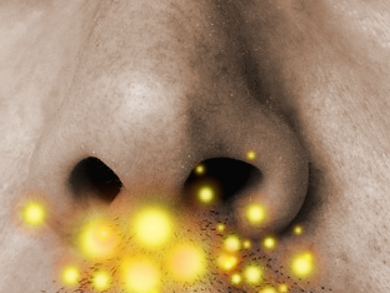The nose-to-brain pathway is a shortcut for direct drug delivery to the brain. It is still unknown, whether and to what extent nanoparticles can be delivered through this passage. Wei Wu, Fudan University, Shanghai, China, and colleagues tracked nose-to-brain transportation of nanoparticles via fluorescence bioimaging strategies using nanoemulsions (NEs) as model carriers. NEs were detected in biological tissues based on the on → off signal switching of the embedded dyes, P2 and P4. DiR and coumarin-6 (C6) were embedded to represent the cargoes.
The team found that NEs with a particle size of about 100 nm, either naked or coated with chitosan, have longer retention duration in nostrils and slower mucociliary clearance than larger ones. NEs as large as 900 nm are very slowly transported along the nose-to-brain passage, due to the faster mucociliary clearance and higher diffusion resistance. However, DiR or C6 signals were found in significant amounts along the nose-to-brain pathway and finally reach the brain. Evidence shows that integral NEs can be delivered to the olfactory bulb, but few to the brain, whereas the cargoes can be released and permeated into the brain in greater amounts.
The researchers think that particle size is more important than coating and that cargoes but few integral NEs are transported into the brain. However, the exact amount of nose-to-brain delivery needs to be validated in future studies.
- Evidence of nose-to-brain delivery of nanoemulsions: cargoes but not vehicles,
Ejaj Ahmad, Yunhai Feng,b Jianping Qi, Wufa Fan, Yuhua Ma,a Haisheng He, Fei Xia,a Xiaochun Dong, Weili Zhao,Yi Lu, Wei Wu,
Nanoscale 2017.
DOI: 10.1039/c6nr07581a




